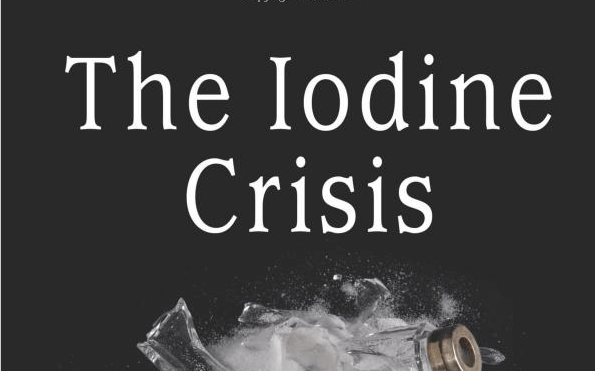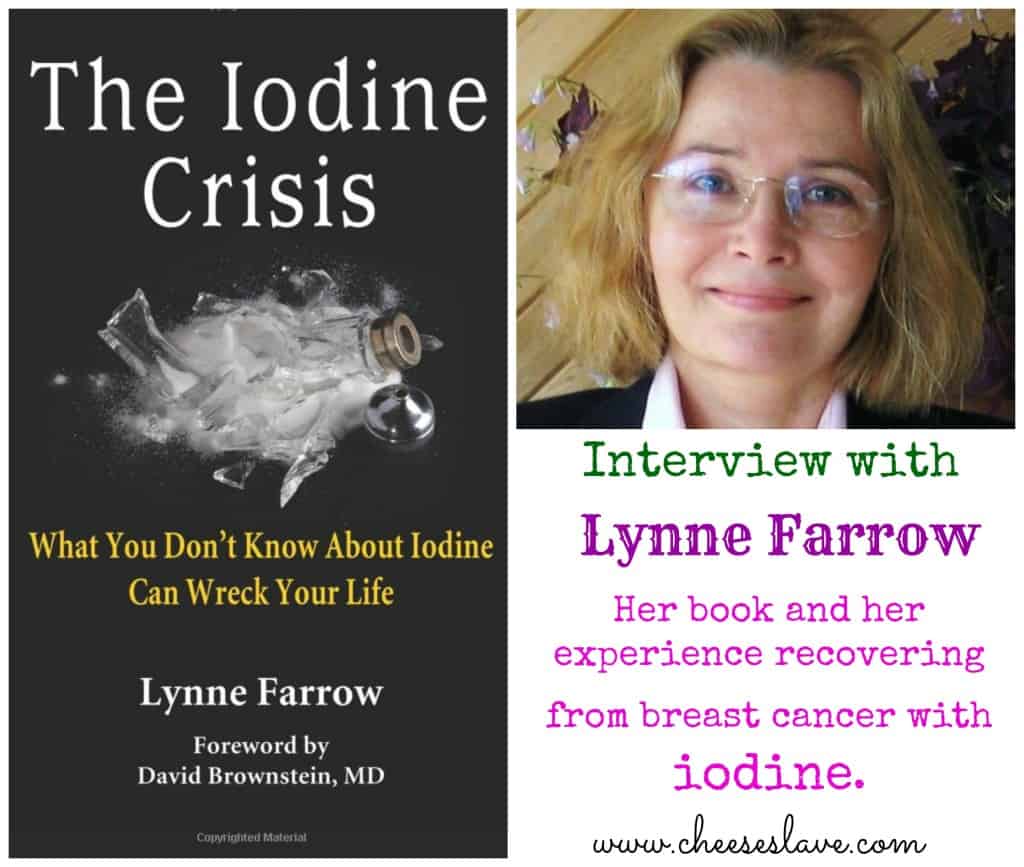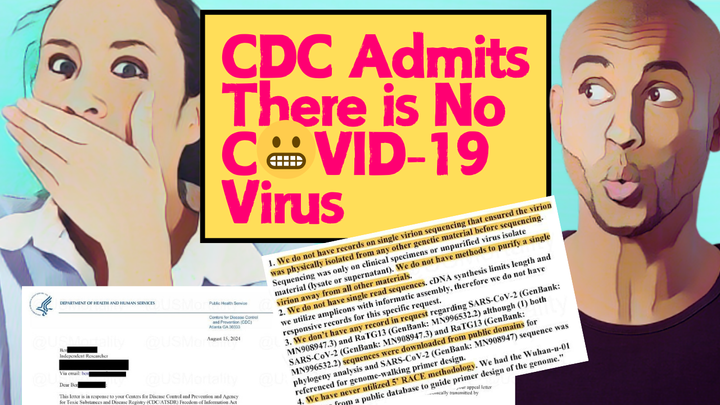Interview with Lynne Farrow, Author of The Iodine Crisis (Part 2)
Lynne Farrow is the author of the important new book, The Iodine Crisis: What You Don’t Know About Iodine Can Wreck Your Life.


This is part two of a two-part interview. Click here to read part 1 of the interview.
Lynne Farrow is the author of the important new book, The Iodine Crisis: What You Don’t Know About Iodine Can Wreck Your Life.
Lynne answered some of my questions about the book and her experience recovering from breast cancer with iodine in this two-part interview.
Interview with Lynne Farrow, Author of The Iodine Crisis
11. Can’t we get enough iodine from eating seafood and seaweed?
You would have to eat shellfish all day long to get a decent amount of iodine.
Unfortunately, seaweed has been recently contaminated with pesticides, oil dispersants, fertilizers and radiation. But even if perfectly clean seaweed was available, the iodine in seaweed sublimes or “evaporates” quickly into the air. So you can never measure the amount you’re getting from seaweed and there is no way to know if you’re getting enough iodine.
It’s essential to know just how much iodine you’re getting, especially if you are at risk for any iodine related condition. See: www.breastcancerchoices.org/seaweed
12. Or iodized salt?
Again, because iodine wafts into the atmosphere quickly after the iodized salt is opened, there may be little or no iodine in the iodized salt canister at the back of your pantry. Unfortunately, the government RDA for iodine was based on the assumption that iodine doesn’t disperse. Nobody checked!
You can read my article, The Iodine Salt Scam: A Three Part Deception.
13. What are the best forms of iodine to take?
The Iodine Doctors recommend the Lugol’s Solution formula of potassium iodide and potassium iodine first used in 1829. Yes, that’s 184 years ago! I personally recommend the Lugol’s formulation available as Iodoral (Lugol’s tablets) manufactured by Optimox or as Lugol’s Solution from Jcrows. There may be other vendors of the Lugol’s formula but these are the only two I can vouch for firsthand.
14. Why is iodine deficiency so common among women who bear children and breastfeed?
Pregnant women are notoriously iodine deficient. This data was uncovered in the mainstream press recently. The impact on low birth weight and the baby’s IQ is evident in women with even slight iodine deficiencies.
When breastfeeding, evolution has programmed the mother’s dietary iodine to reroute the lion’s share of her iodine toward nourishing the baby. But the baby still may not get enough from breastfeeding if the mother’s intake is low. Unfortunately, moms rely on prenatal vitamins which usually contain inadequate iodine.
15. Why does the thyroid gland swell (goiter, nodules) when we are iodine deficient?
The thyroid usually swells and develops nodules in an attempt to expand the tissue to trap more iodine from the bloodstream. Sometimes the breasts and thyroid temporarily swell after the introduction of iodine supplementation in an attempt to stockpile the available incoming iodine.
16. Why do we develop cysts in the breasts and ovaries when we are iodine deficient?
From my understanding of physiology and from following iodine-taking patients for seven years, breast cysts usually develop as a result of either toxins or inflammation not eliminated by adequate iodine nutrition. When the breast doesn’t have the nutritional resources to clean itself of toxins, the stagnation causes trouble. The cyst seems to be the body’s attempt to wall off a problem area. The breasts, the ovaries and the thyroid all appear to swell and develop nodules or fibrous tissue in a similar way.
We’ve followed women whom we call “Iodine Deficiency Trifectas” because they’ve experienced all three– breast, ovary and thyroid issues — in the course of their lives.
17. What is the biggest problem you hear about with people supplementing iodine?
The biggest problem occurs when people go to a well-meaning practitioner who is uninformed about iodine, iodine testing or the companion nutrients. So he or she doesn’t know how to dose and then misinterprets what happens when the patient gets symptoms.
For example, occasionally a patient may start taking iodine and their thyroid or breasts may swell or get nodular. The practitioner orders a TSH test. When the test falls out of normal range, he or she wrongly interprets the patient’s symptoms as hypothyroid.
The practitioner says, “I told you about the Wolff Chaikoff Effect I learned about in medical school that insists iodine causes hypothyroidism. You must stop iodine immediately!”
The patient feels chastened and will never touch iodine again. In my opinion, as a result of uneducated practitioner misinterpretation, the patient could be put at risk for serious disease.
If the patient had gone to an iodine literate practitioner in the beginning, the scenario would play out differently. First, the interpretation of swelling and nodules would be interpreted as the result of such an extreme iodine deficiency that the tissue expanded to trap the sudden bounty of iodine. The iodine deficient body may hoard iodine because it’s so used to an iodine famine that it wants to stock up.
Secondly, the TSH test would be considered unreliable because the patient is taking iodine. One patient had a TSH result of 80 when she but she felt perfectly fine. Her doctor was conscientious enough to contact an iodine literate physician before ordering her to stop iodine. He also read Dr. Jorge Flechas’ paper explaining how TSH levels can be misleading in iodine takers.
18. Can people with Hashi’s take iodine?
I had slight Hashi’s myself, as did a lot of the iodine takers on the online groups who can vouch for iodine’s success in their healing. After taking iodine for a while, my practitioner reported I had no detectible antibodies.
Most people with Hashi’s don’t get any antibody flare-up from iodine. Those who do need to learn about the necessity of selenium and getting the iodine dose up high enough so that iodine protects the thyroid.
For Hashi’s people, I recommend working closely with an iodine literate practitioner who is familiar with Drs. Abraham and Brownstein on Hashi’s. Also, reading Dr. Jeffrey Dach’s articles on Hashi’s will be helpful.
https://jeffreydach.com/2009/11/07/selenium-for-hashimotos-thyroiditis-by-jeffrey-dach-md.aspx?view=linear
https://jeffreydach.com/2011/09/14/iodine_hashimotos.aspx
19. Is there anyone who can’t take iodine (such as people allergic to shellfish)?
The allergens in shellfish and the allergen in a radioactive contrast dyes are completely different than the nutritional iodine in an iodine supplement. Iodine is present in every cell in your body and you can’t live without it. People are commonly asked if they are allergic to iodine before taking a CT scan even though there is no science behind the statement. I’m allergic to the radioactive contrast dye myself (hives) but have been taking substantial doses of iodine with no allergic reaction.
20. Can some people be sensitive to iodine supplementation?
Certain people are sensitive to even the smallest amount of iodine. What often works is diluting one drop of Lugol’s down with ten drops water and applying it to the heel skin, then gradually building up the drops along with taking the companion nutrients.
21. What is the iodine loading test and why is it important?
The Iodine Loading Test helps measure how much iodine is excreted after consuming 50 mg iodine. If your body is deficient, it will absorb much of the 50 mg and so less will come out in the urine. There is an exception when the iodine absorber tissues are missing (due to lack of need) or damaged due to bromines, toxins and oxidation. An iodine literate practitioner should know how to interpret the test.
22. Where is the Iodine Protocol listed and how does a person begin taking iodine?
The complete Iodine Protocol devised by the Iodine Project doctors is listed on pages 201-202 of The Iodine Crisis.
An example of how one experienced iodine doctor starts his patients on iodine is spelled out in the FAQ section on page 24 of The Iodine Crisis. The protocol is a time-tested system for taking iodine. Patients who just begin taking iodine willy-nilly may benefit –- or they may get themselves into an unpleasant detox situation. For example, in the beginning, I didn’t know about the salt loading protocol for my detox symptoms.
23. What is the salt loading protocol and why is it so important?
The unprocessed sea salt captures the detoxing bromines and toxins and escorts them out of the body so it doesn’t get stuck in the tissues such as the brain or sinuses. If that doesn’t work, that’s a signal that you are taking too much and need to STOP iodine for 48 hours to let your kidneys and detox pathways flush the bromines and toxins.
24. What are some signs of bromide detox? Are cherry angiomas a sign of bromide detox? (I wrote a post about cherry angiomas and the possible link to bromide detox before I read The Iodine Crisis.
Yes, cherry angiomas are an often fast-appearing sign of bromide detox. Even people taking bromide medications report these skin reactions.
Before iodine, I bought a new mattress (bromide fire retardants) and within a month I noticed cherry angiomas on the trunk of my body.
25. Last question. Did you write The Iodine Crisis because you discovered a hot, new treatment that helped you and others?
No, I wrote the book because I researched iodine-based medicine back 15,000 years to prehistoric times, then up through the Egyptian papyrus records, and then the Golden Age of Iodine in the 1800s. I realized I stumbled on the world’s oldest, most traditional medicine which had been essentially removed from patient use after a wrong-headed research paper from 1948.
Iodine was stolen from us, as I say. Nothing new or high tech or expensive ever helped me, but the long-lost iodine changed my life. I felt I needed to share my research journey and answer the question, Who stole iodine?
Order The Iodine Crisis
Click here to order a copy of The Iodine Crisis.



Comments ()